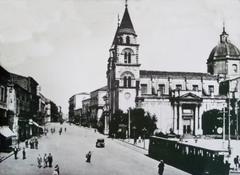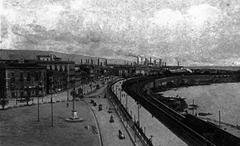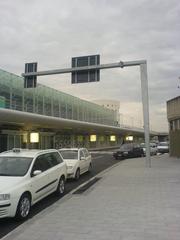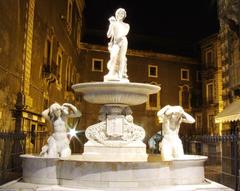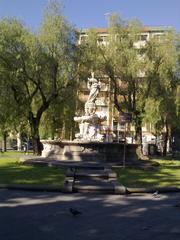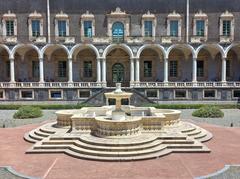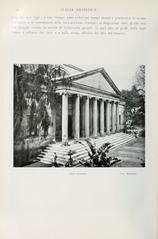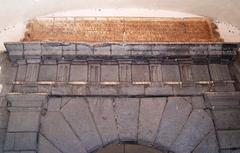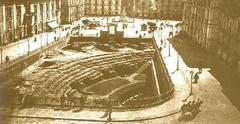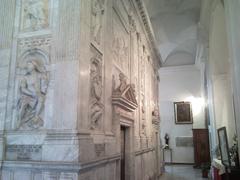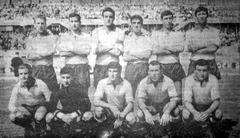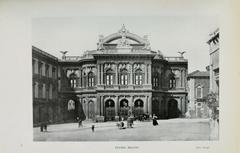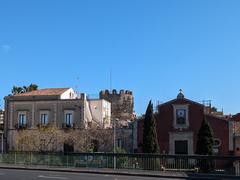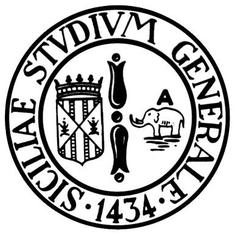
Terme della Rotonda Catania: Comprehensive Guide to Visiting Hours, Tickets, and Historical Insights
Date: 04/07/2025
Introduction
Nestled in the heart of Catania’s historic center, the Terme della Rotonda is a remarkable archaeological site that bridges the ancient Roman world, Byzantine spirituality, and Baroque artistry. Originally constructed as a Roman bath complex between the 1st and 2nd centuries CE, it later transformed into the church of Santa Maria della Rotonda during the Byzantine era, encapsulating centuries of Sicilian history and architectural innovation.
Visitors today will encounter a fascinating blend of ancient engineering, medieval frescoes, and evidence of urban evolution that makes the Terme della Rotonda a must-visit for anyone interested in Catania’s layered past. This guide provides all the essential information—visiting hours, tickets, accessibility, nearby attractions, and historical context—to enhance your experience at this unique site (Parco Archeologico e Paesaggistico di Catania e della Valle dell’ACI; MuseiOnline).
Table of Contents
- Historical Overview
- Architectural Highlights
- Visiting Information
- Practical Tips & Nearby Attractions
- FAQs
- Summary & Resources
Historical Overview
Roman Origins and Construction
The Terme della Rotonda was built between the 1st and 2nd centuries CE, during a period of prosperity in Roman Catania. The baths featured a central domed hall (the “Rotonda”), with several ancillary rooms for bathing rituals, including the frigidarium, tepidarium, and caldarium. Advanced hydraulic engineering, such as a large cistern and a connection to the city’s Roman aqueduct, ensured a steady water supply (Comune di Catania; enjoysicilia.it).
Transformation Through the Ages
After the decline of the Western Roman Empire, the baths were gradually abandoned. In the late 6th century CE, the complex was repurposed as the Byzantine church of Santa Maria della Rotonda. This adaptation involved significant architectural modifications, including the addition of an apse, chapels, and religious frescoes.
Medieval and Baroque periods brought further changes: the dome was reinforced, chapels added, and new fresco cycles painted. The structure even served as a burial site and underwent restoration after the 1693 earthquake that devastated much of Catania (wikipedia.org; Catania Today).
Architectural Highlights
Roman Bath Features
- Central Rotonda: A circular hall (approx. 22 meters in diameter) once covered by a grand dome, showcasing early Roman vaulting techniques.
- Bath Chambers: Ancillary rooms, including the frigidarium, caldarium, and hypocaust systems (with well-preserved pilae and suspensurae), reveal the baths’ original opulence (Sicilia Archeologica).
- Water System: A large cistern and castellum aquae, linked to the Roman aqueduct, highlight the site’s hydraulic ingenuity (enjoysicilia.it).
Byzantine and Baroque Adaptations
- Church Conversion: The Rotonda was converted into a church, with the addition of an apse, chapels, and sacred frescoes. Medieval and Baroque fresco cycles depict saints, the Madonna, and other religious iconography (parchiarcheologici.regione.sicilia.it).
- Architectural Layers: Entrances from the 13th and 16th centuries, Renaissance limestone portals, and contrasting lava stone details reflect the site’s continuous adaptation.
Visiting Information
Opening Hours & Tickets
- Regular Hours (as of July 2025): Wednesdays and Sundays, 9:00 AM – 1:00 PM. Last entry at 12:30 PM.
- Other Days: Visits outside these hours require advance booking via the official MuseiOnline page.
- Admission: Free; no tickets required.
Accessibility
- Wheelchair Access: Limited due to historic architecture; uneven floors and narrow passages may restrict access.
- Recommendations: Visitors with mobility needs should contact the site in advance for assistance and to discuss accommodations.
Guided Tours & Events
- Guided Tours: Available for groups or outside regular hours—book in advance via the MuseiOnline page.
- Special Events: Cultural events, exhibitions, and lectures are held periodically. Check the official site or local tourism offices for updates.
Getting There
- Location: Via della Rotonda, Catania historic center.
- Transport: Easily reachable on foot from Piazza Duomo and other landmarks. Public transport and taxis are available; parking is limited due to narrow streets—use public transport or park further away and walk.
Site Layout & Visitor Flow
- Entrances: 16th-century limestone southern portal and 13th-century lava stone western entrance.
- Tour Route: Square nave, domed chamber, four corner chapels, and accessible Roman bath remains including hypocaust chambers and mosaic fragments.
- Interpretation: Self-guided tours with signage; some English-language materials may be available. QR codes and brochures often supplement the visit.
Practical Tips & Nearby Attractions
- Best Time to Visit: Early mornings on open days to avoid crowds and enjoy natural lighting through the dome.
- Dress Code: Modest attire recommended due to the site’s religious history.
- Photography: Permitted for personal use; professional equipment requires authorization.
- Amenities: No on-site café or gift shop; restrooms are limited. Many cafés and shops nearby.
- Nearby Sites:
- Roman Amphitheatre of Catania
- Monastery of San Nicolò l’Arena (UNESCO site)
- Piazza Duomo and Via Etnea
Frequently Asked Questions (FAQ)
Q: Are tickets required to visit Terme della Rotonda?
A: No, admission is free. Advance booking is needed for visits outside regular hours.
Q: What are the visiting hours?
A: Wednesdays and Sundays, 9:00 AM to 1:00 PM.
Q: Is the site accessible for people with disabilities?
A: Accessibility is limited; contact the site beforehand for support.
Q: Are guided tours available?
A: Yes, for groups and visits outside standard hours—book in advance.
Q: Can I take photographs?
A: Yes, for personal use. Professional equipment requires permission.
Summary
The Terme della Rotonda is a living chronicle of Catania’s evolution—from Roman public baths to a Byzantine and Baroque church. Its unique architecture, rich frescoes, and continuously adapted structure capture the city’s resilience and cultural diversity. With free admission, central location, and proximity to other major sites, it offers an exceptional window into the urban history of Sicily.
For an enriched visit, download the Audiala app for audio guides and interactive maps, and consult official resources for the most current information (Parco Archeologico e Paesaggistico di Catania e della Valle dell’ACI; MuseiOnline).
References
- Visiting Terme della Rotonda: History, Tickets, Hours & Travel Tips in Catania, 2024 (parchiarcheologici.regione.sicilia.it)
- Terme della Rotonda Catania: Visiting Hours, Tickets, and Historical Highlights, 2024 (enjoysicilia.it)
- Cultural and Historical Significance of Terme della Rotonda, 2024 (comune.catania.it)
- Terme Della Rotonda Visiting Hours, Tickets, and Guide to Catania’s Historic Site, 2025 (museionline.info)
- Wikipedia contributors, Terme della Rotonda (Catania), 2024 (en.wikipedia.org)

